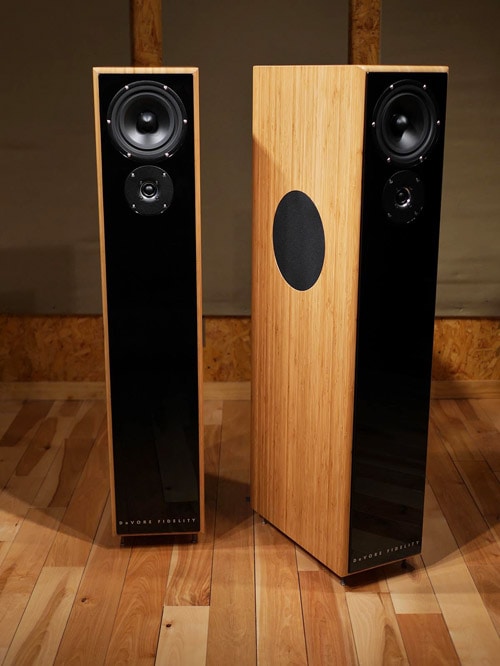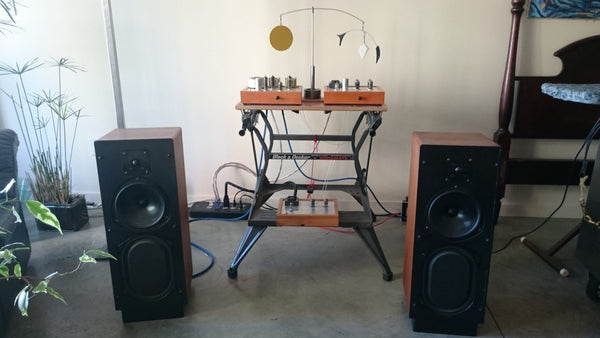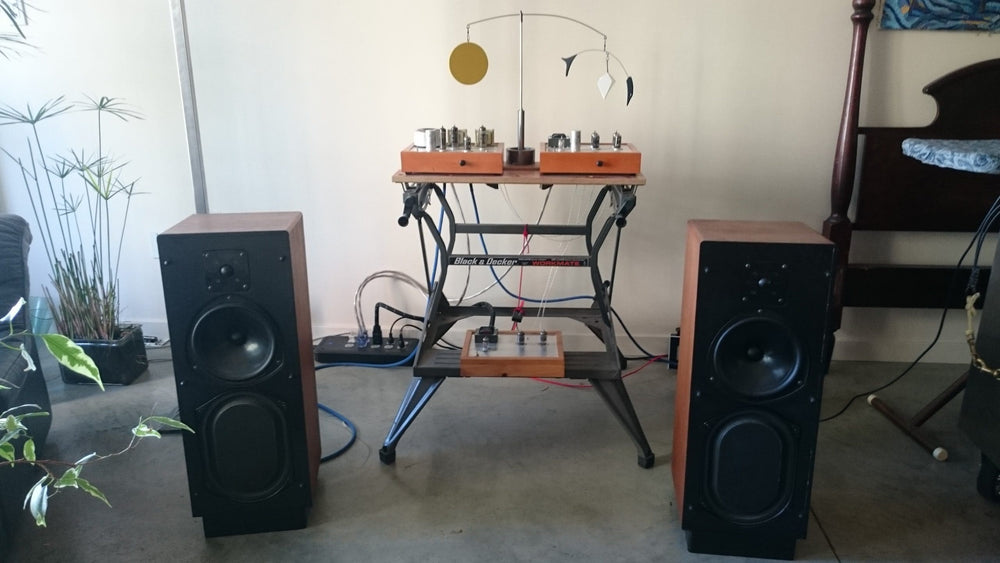In Copper #18, we addressed the critical importance of getting the smoothest bass from our main (full-range speakers). This step is foundational for properly integrating our subs to the main speakers.
Before we get into our promised next section on installing/integrating our subs, we should briefly address two related issues…
1 – Power up, volume down – While you are getting your mains to have the smoothest bass, and when you are making final adjustments to them to achieve the best presence and tone they can provide, it’s important to have your subs powered up, but receiving no signal. Since you won’t be listening to them and they cannot make any sound if the input is turned down completely, the question is why even turn them on?
We don’t want the subs’ bass driver(s) to be moving around in response to the sound emanating from the mains. I’ve heard this phenomenon referred to as sympathetic resonance. What a poor description! IMO, unsympathetic resonance is more correct. Why allow the subs to interfere with our voicing of the mains by allowing them to play along with the mains, but probably out of tune and time?
While not perfect in its effect, powering up the subs more effectively locks the sub driver in the ‘zero’ position. During this time I keep the subs nearby the mains – in an area where I am likely to locate them after our upcoming tests – maybe three feet or so away, perhaps beside them but more likely in an arc somewhere slightly or even directly behind them.
2 – Time Delay – Without going into the sometimes argued time delay issue, let me say that it doesn’t seem to be an issue when we are likely going to bring the subs in at about 30 Hz, give or take a few cycles. At these frequencies, with their very long wavelengths (say, 32-40 feet long), this issue seems to be irrelevant (although 0-180 polarity of the subs is still important – which we will discuss).
So let’s get on with our sub installation/integration…
Aim to Please
No one seems to talk about this issue, nor have I ever seen it in practice, except on my voicing sessions, but – short of balance, crossover frequency selection, subwoofer volume, and polarity – (all of which we will discuss after this article), it is the vitally important next step to properly integrating your mains to your subs. And when done, the musical impact is substantial, as compared to before, with one possible exception to be mentioned later.
Everyone sits their subs down (hopefully in a good place), and points them essentially straight ahead. That means that, unless they get lucky, chances are that their subs could perform at a higher level, and they will never experience the potential improvement.
May I suggest a better placement method?
And it is not the oft-repeated “place the woofer at the seat and walk or crawl around the room near the main speakers to hear/discover the best place to put the subs”. We are gonna do something with a substantially higher success ratio.
Before we go into the sub placement and direction technique, I want to make another suggestion that you obtain an RTA: a Real-Time Analyzer. (Hold on now – this is not about using it to measure the set-up – please hear me out.) As I mentioned earlier, they can be quite inexpensive, and sometimes almost free.
If you own just about any full-range speakers and a pair of subs, the expense of a RTA system is relatively insignificant. Operating it is simple – it doesn’t require an engineering degree for what we will be doing. For example, we will only care about the frequencies below 100-120 Hz.
If you choose a system that requires a mic, be sure to get one with an omni (pick-up pattern) capsule. They are several inexpensive mics out there from Behringer, Dayton, Audix, & others. A quick search on Amazon or elsewhere will turn up a decent selection. Also, be sure that whatever system you use to display the measurements has an adequate mic preamp. This is one reason I tend to like the Studio Six Digital AudioTools RTA. Its onboard calibrated mic is generally acceptable for our task. And fir even higher accuracy, it’s a snap to use their iTest mic with your iPhone or iPad. Just plug its mic cable connector in to the charger outlet, and not only does it work, it automatically calibrates the system to that mic!
The reason we want to use a RTA when possible is that it dramatically saves time and it eliminates the typical human error that is prevalent when trying to evaluate the sub placement by ear at low frequencies.
FWIW – I have been using a 1/3 octave RTA for this particular room/speaker voicing task since 1979. Although I have occasionally had to voice sub placement & angle by ear, I cannot imagine being captive to that technique, particularly in this app/centric age in which we live.
Why 1/3 octave, you ask? I’ve found that 1 octave is too general, not showing what is really happening. Sixth octave or higher measurements tend to confuse the casual user (and me). Maybe it is TMI – Too Much Information. It seems as if 1/3 octave is more similar to what we are likely to hear.
We want to use pink noise as our source and set the RTA on flat, unweighted (not A or C weighting). As mentioned before, run the pink noise at a level that is 20 dB above the (flat weighting) ambient room noise level.
Of course you could do this by ear if need be, but as I mentioned above, it is much more difficult and time consuming.
Ten step process
1 – We will place our mic or other measurement device at the by-now-optimum listening position, at ear height. By now optimum, because we found it in Copper #18.
2 – To begin, assume the sub is approximately three feet away from the mains. We will test our directionality at each location in a 3 feet-from-the-speaker arc and try several other locations to find the best one. You may not end up at 3 feet, but this gives us a starting point.
3 – We’ll do one sub at a time. Keep the other one powered up but turned down. Be sure to cut off the main speakers.
4 – Set the sub to crossover at a much-higher-than-expected setting – say 100-120 HZ. We do this so that we can see any resonances that will be present before we apply the crossover at a lower setting. Even though we will roll-off the sub at a lower frequency, we do not want to allow a big peak (room resonance) at say, 50-60 Hz. If the peak is large enough, it will still contribute to a muddiness sometimes attributed to a “slow” sub.
5 – After we have noted the frequency response (peaks and dips) of the sub when pointed straight ahead, let’s rotate it 90 degrees to the side, generally pointed at the opposite channel’s speaker. Before this rotation, we want be sure that we have noted (it’s best to write it down) any obvious peaks & dips, their amplitude, and their frequencies.
6 – We will do the same measurements with the sub now generally aimed at the opposite speaker. You will notice some change in response. For now, just keep a record of it.
7 – Do the same with the sub pointed backwards. Yes I know that it looks weird. But if that is the best direction, you can find a way to obscure the back panel. I know, because my own pair face backwards. And visitors who come here for the RoomPlay Reference sessions consistently report that it was the most musically involving listening session they’ve had, short of live music.
Again, note the differences.
8 – Fire the sub towards the adjacent wall. Again note the differences.
Depending on your curiosity and patience, do the same process again at another location along the arc. I generally do it at three positions.
9 – When you find the best location & direction for your sub (smoothest bass), depending on your curiosity and patience, you may want to try a position that is between the two best – in other words at 45 degree angles. This usually pays off, if for no other reason than you have confidence that you have found the best location & firing direction for that sub. Later, if you wish, you can try other locations – say on a slightly larger or smaller arc. However, what you have found almost certainly eclipses what you could have gotten otherwise, so I usually leave it there and may come back at a later time if I have the time & patience.
10 – Now we will do the other sub. Caution, DO NOT expect that it will end up in a similar location or direction. Rooms can be different, and unless yours is especially well balanced dimensionally, or you get lucky, it may be different. We only care about the result at this point – the smoothest bass.
Be sure to turn the first sub down or disconnect its input.
We will finish with the set-up techniques (sub balance, level, crossover point, polarity, etc.) next issue. As with this issue, in Copper #20 there will be some things you can do (that I do not generally see or hear mentioned) that can make a real performance difference. And except for relative balance, the rest of the way will be by ear, not by measurement.
Oh, the possible exception that I mentioned in the Aim to Please first paragraph? Maybe you will get lucky and your subs will work well without much effort and with them facing directly ahead.
Good luck with your project! Done properly, it will pay musical dividends for years to come.
See you next time!

















